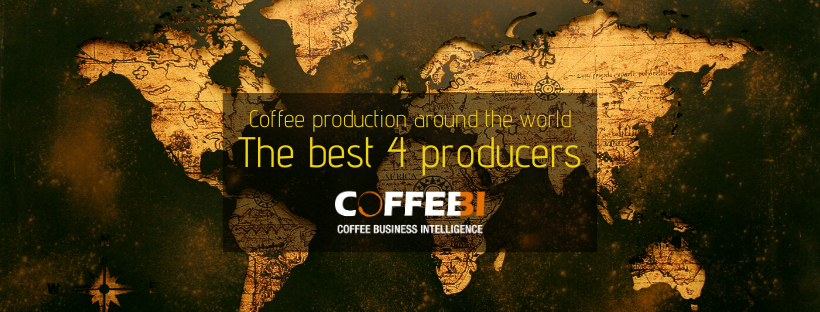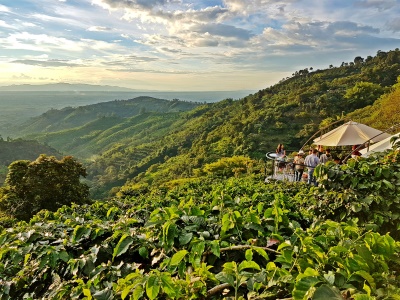Coffee production around the world: the best 4 producers
Coffee, after water and tea, is the third most consumed beverage around the world. With a café at every corner in almost every city in the world, it is no doubt that coffee is one of the most favorite drinks around the world. After oil, coffee is the second most exported and imported commodity around the globe.
Coffee beans have many beneficial uses, from being used as a beverage, coffee beans are used in pharmaceuticals and cosmetics. Coffee thrives in warmer locations, but anywhere that the weather is too extreme, as the weather in northern and southern poles, growing coffee is just not possible.
Good quality beans require suitable weather and proper care. Most of the coffee producing countries around the globe share similar geographical characteristics and weather conditions. Let’s discover the largest coffee producers in the world:

Brazil and its production process
Brazil is number one on our list as it the world’s largest producer of coffee. Brazil has been the highest producer of coffee worldwide for over 150 years, with a production of 2,595,000 metric tons of coffee beans.
About 300,000 plantations are spread over more than 10,000 square miles of landscape, which includes states such as Minas Gerais, Sao Paulo, and Parana, where the temperature and climate are well suited for the production of coffee.
The coffee production process in Brazil is different and more natural as compared to other coffee-producing countries. The dry coffee production process is implemented instead of the wet method where coffee beans are washed with water. In the dry process, coffee cherries are left out in the air to dry, and the sunlight dehydrates them.
The mass production of coffee plays a pivotal role in the economy of Brazil. The best thing about Brazilian coffee is that it is soft, nutty, low in acidity, and offers a nice bittersweet chocolate taste. Because of this, Brazilian coffee makes for an excellent base for making flavored coffee, making it one of the most popular choices for homemade coffee.
Vietnam and its expansion in coffee production
Vietnam is the second-largest producer of coffee with a production of nearly 1,650,000 metric tons of coffee per annum. Though the Vietnam War caused a gap in the coffee business, Vietnam experienced a rapid expansion in coffee production from only 6,000 tons in 1975 to almost 2 million tons in 2016.
Vietnam’s primary export is the less expensive Robusta bean, and it is the world’s number one producer of Robusta coffee across the globe. Robusta beans have twice the caffeine than Arabia beans, which gives it a more bitter taste. Many – people are familiar with the signature Vietnamese coffee that is a mixture of coffee with sweet condensed milk, but they’re so many variations, such as the use of yogurt, fruits, and even eggs. This has led Vietnamese coffee to develop a style of its own.
Colombian and its coffee quality

Colombia was second to Brazil for coffee production but has moved to the third spot due to the rapid expansion of coffee production by Vietnam. Moreover, climate change has affected the production of coffee. However, still, the coffee form Colombia is world-famous, and Colombia remains a crucial player in the coffee game around the globe.
Colombia produces 810,000 metric per tons of coffee per annum. A leaf disease hit Colombian coffee crops in 2008 and 2009 due to heavy rains. This resulted in a 40% decrease in its coffee production, but Colombia has managed to make a comeback by replacing the trees with rust-resistant varieties.
Colombia is the second highest producer of Arabia beans, which have a sweet taste and are less bitter than Robusta coffee beans. If you are looking for a slightly sweet taste with hints of chocolate and nuts, then you should go for Arabica beans.
Indonesia is the rising coffee star
Indonesia may not be famous as a top coffee producer, but it produced over 660,000 metric tons of coffee in 2016. Indonesia is near the equator and has many mountainous regions that are best for the production of coffee. It produces the less valued Robusta beans as its climate is better suited to Robusta beans production. Currently, coffee plantations cover over one million hectares of Indonesia’s land.
It is the third-largest producer of Robusta beans in the world. The coffee industry in Indonesia is home to about 1.5 million farmers who have production companies of their own, and they do not take the process of coffee production lightly, which is seen in the end product as Indonesia produces some of the rarest coffee around the world.
Indonesia’s most famous coffee specialty is kopi luwak. These are the most expensive coffee beans in the world as they are harvested from the feces of Asian palm civets through an intensive process. It has a very unique and distinctive taste.
There are plenty of delicious coffee recipes that are made using the fresh coffee beans provided by these countries. Turkish coffee is brewed in a unique way, and is very common in the Levant. Turkish coffee is made unfiltered with so finely ground coffee beans that they resemble cocoa powder. Coffee beans take really hard work and care to grow. Coffee production is a significant business in the world, and it also includes countries like Ethiopia, Honduras, Uganda, Peru, India, and Mexico. Each of these countries contributes significantly to the coffee trade worldwide.



